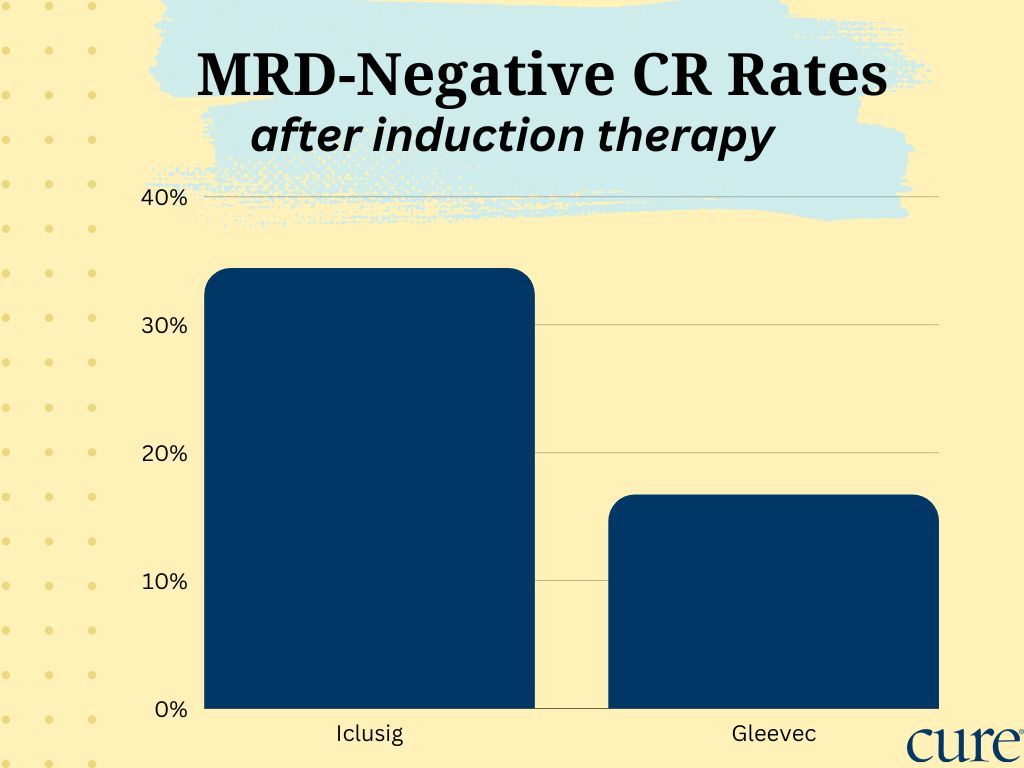News
Article
Iclusig Boosts MRD-Negative Complete Response in Ph-Positive ALL
Author(s):
Iclusig plust reduced-intensity bested Gleevec when it came to MRD-negative complete remission in patients with Philadelphia chromosome-positive acute lymphoblastic leukemia.
Adding Iclusig (ponatinib) to reduced-intensity chemotherapy increased minimal residual disease (MRD)-negative complete remission (CR) rate — meaning that no traces of cancer were found after treatment — in patients with Philadelphia chromosome (Ph)-positive acute lymphoblastic leukemia (ALL), according to findings from the phase 3 PhALLCON trial that were recently presented at the 2023 School of Hematologic Oncology Annual Meeting.
Specifically, the Iclusig-containing regimen produced better MRD-negative CR rates thatn Gleevec (imatinib), study results showed.
Iclusig had better MRD-negative complete response rates than Gleevec in patients with Ph-positive acute lymphoblastic leukemia, recent research showed.

At the Aug. 12, 2022, data cutoff, patients who received Iclusig (154 patients) experienced an MRD-negative CR at the end of induction (treatment with the goal of achieving a complete response) at a rate of 34.4% compared with 16.7% in the Gleevec arm (78 patients). Additionally, the MR4 MRD negativity rates at the end of induction regardless of CR assessment were 41.6% vs 20.5%, respectively. The median follow-up was 20 months (range, 18-24) in the Iclusig arm and 18 months (range, 14-24) in the Gleevec arm.
“Today, TKIs and chemotherapy or steroids are the standard of care in Ph-positive ALL,” Dr. Elias Jabbour, a professor in the Department of Leukemia, Division of Cancer Medicine, at The University of Texas MD Anderson Cancer Center in Houston, said during the presentation. “We know that the remission is not long lasting. And we know that complete molecular response matters a lot (as) resistance is driven by the acquisition of the T315I mutation.”
PhALLCON enrolled adult patients with newly diagnosed Ph-positive or BCR::ABL1-positive ALL. Eligible patients needed to have an ECOG performance status of 2 or less, meaning that they were able to independently complete all or most of their daily tasks; no history or current diagnosis of chronic-, accelerated- or blastic-phase chronic myeloid leukemia; and an absence of clinically significant of uncontrolled cardiovascular disease.
Patients were randomly assigned to reduced-intensity chemotherapy in combination with Iclusig 30 mg once daily with dose reduction to 15 mg once daily (164 patients) after MRD-negative CR in the induction phase or reduced intensity chemotherapy with Gleevec at a starting dose of 600 mg once daily (81 patients). During the induction phase, patients received the TKI plus vincristine and dexamethasone in three 28-day cycles, after which the primary end point was assessed, then they proceeded to the consolidation phase which consisted of the TKI plus methotrexate and cytarabine in six 28-day cycles, followed by maintenance therapy with the TKI plus vincristine and prednisone in eleven 28-day cycles, and finally treatment with TKI monotherapy until the completion of the study. Additionally, during the first six cycles, intrathecal therapy (therapy administered near the spinal cord) was given twice per month to mitigate central nervous system disease prophylaxis.
The primary end point was MRD-negative CR, and a key secondary end point was event-free survival (death, resistant leukemia, relapse, or secondary malignancy). Molecular response rates, duration of MRD-negative CR, overall survival (time from treatment until death of any cause) and safety represented other secondary end points.
The baseline patient characteristics were well balanced between the two arms; the median age was 54 years (range, 19-82) in the Iclusig arm and 52 years (range, 19-75) in the Gleevec arm. Most patients in both arms were female (55% vs 53%), had an ECOG performance status of 1 or less (96% vs 94%), had p190 as the dominant BCR::ABL1 variant (70% vs 65%), and had at least one cardiovascular comorbidity (56% vs 64%).
The median leukocyte and leukemic blast counts, which measure types of white blood cell and can be predictive of prognosis, were similar between the two groups as well.
Additional findings from the study revealed that the duration of MRD negativity was not estimable — meaning that not enough patients had an ALL-related event — vs 20.9 months among patients who achieved MRD negativity in the Iclusig (62 patients) and Gleevec arms (15 patients), respectively. In the overall populations, the times to treatment failure were not estimable vs 21.9 months, respectively.
Patients in both the Iclusig and Gleevec arms went on to receive a subsequent anticancer therapy (35% vs 57%). Subsequent anticancer therapies included first-generation BCR::ABL1 TKIs (10% vs 9%), second- or third-generation BCR::ABL1 TKIs and/or immunotherapy (19% vs 37%), and Iclusig-based treatments (8% vs 16%).
In PhALLCON, EFS was defined as death due to any cause, failure to achieve CR by the end of induction, or relapse from CR. There were 34 EFS events in the Iclusig arm compared with 24 in the Gleevec arm; the median EFS was not estimable vs 29 months, respectively.
Progression-free survival (PFS; time from treatment until disease progression or death) was analyzed in a post hoc analysis. The median PFS was 20 months compared with 7.9 months in the Iclusig and Gleevec arms, respectively. The median OS was not estimable in both groups, meaning that more than half of the patients in each group were still alive at the time of data collection.
Patients with MR4 MRD negativity in the Iclusig and Gleevec achieved molecular responses in cycle 3 at rates of 43% (61 of 142 patients) vs 22% (15 of 68 patients). In cycle 5 these rates were 63% (57of 90 patients) vs 52% (17 of 33 patients), respectively, 70% (41 of 59 patients) vs 40% (eight of 20 patients) in cycle 7, and 92% (44 of 48 patients) vs 47% (n = seven of 15 patients) in cycle 9.
In the Iclusig and Gleevec arms, respectively, patients with MR4.5 MRD negativity (BCR::ABL1 ≤ .0032%) had molecular response rates of 27% (n = 38 or 142) vs 15% (n = 10 of 68) in cycle 3, 40% (n = 36 of 90) vs 30% (n = 10 of 33) in cycle 5, 48% (n = 28 of 59) vs 25% (n = 5 of 20) in cycle 7, and 63% (n = 30 of 48) vs 27 (n = 4 of 15) in cycle 9.
Safety findings showed similar adverse effect profiles for Iclusig and Gleevec. Treatment-emergent side effects were reported in both the Iclusig arm (163 patients) and the Gleevec arms (81 patients) at a rate of 99%. These includes serious side effects (60% vs 56%), moderate to severe side effects (90% vs 93%), treatment-emergent deaths (5% vs 5%), treatment-emergent arterial occlusive events (2% vs 1%), and treatment-emergent venous thromboembolic events (12% vs 12%).
Dose discontinuation (10% vs 9%), reduction (20% vs 22%), and interruptions (68% vs 40%) occurred in both arms.
In the Iclusig and Gleevec arms, the most common moderate to severe blood-related side effects were decreased platelet count (63% vs 58%), decreased white blood cell count (53% vs 49%) and decreased neutrophil count (49% vs 46%). Grade 3/4 nonhematological side effects included increased alanine transaminase levels, which indicate liver damage (19% vs 9%), low levels of potassium (6% vs 19%) and high blood pressure (12% vs 6%).
At the data cutoff, 41% of patients in the Iclusig arm remained on study treatment compared with 12% in the Gleevec arm. Patients discontinued study treatment at rates of 58% vs 86%, respectively, due to lack of efficacy (7% vs 26%), side effects (12% vs 12%), progressive disease (4% vs 6%), hematopoietic stem cell transplantation (HSCT; 30% vs 37%), and other reasons (4% vs 5%).
Patients discontinued study at respective rates of 18% and 22%, with death (13% vs 16%), withdrawal (4% vs 5%), being lost to follow-up (0% vs 1%), and other reasons (1% vs 0%) being the reported causes. Patients in both arms received HSCT at any time at rates of 34% vs 48%, respectively.
“This study has established (Iclusig) as the standard of care for Ph-positive ALL,” Jabbour said. “It is superior to (Gleevec) in inducing a higher rate of MRD negativity at 12 weeks. This superiority was associated with a better PFS and improvement the long-term EFS. (Although) we see an advantage in efficacy, we did not see an increase in AEs. Therefore, based on these data, we hope that Iclusig will be approved.”
For more news on cancer updates, research and education, don’t forget to subscribe to CURE®’s newsletters here.




